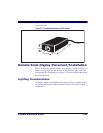
2-16 0DJHOODQ 6FDQQHU
&KHFNVWDQG0RXQWLQJ
There are a number of things to take into account when installing the unit
into a checkstand. Key factors are ergonomic/worker safety, loading capac-
ity and stability. Consider the scanner or scanning-scale’s weight when cal-
culating the robustness of construction needed to support it as well as
maximum capacity of weighed and scanned items.
,QVWDOODWLRQ2YHUYLHZ
The preceding Site Preparation Overview dealt with installed location and
counter preparations to accommodate the scanner or scanning-scale. Hav-
ing completed those steps, physical installation of the scanner or scanning-
scale can begin. The following instructions apply to all models.
This section describes:
1. Unpacking the unit.
2. Verifying operation before connecting to a POS system.
3. Routing and connecting cables.
4. Validating that your scanner communication parameters match
the POS terminal’s system requirements.
5. Functional testing to verify operation when connected to the
POS system.
The following text describes each of these steps.
8QSDFNLQJ
To un pack the unit :
• Inspect the package for signs of damage that may have occurred
during shipping. If damage is found, report it to your carrier
immediately.
NOTE
If you choose to rout a countertop with a thickness of 0.75” (1.9 cm) ply-
wood, you’ll need to add a backing strip that supports the area routed out for
the support flanges (see Figure 2-5). This support strip should minimally be
made of 0.75” (1.9 cm) thick plywood and be approximately 4.0” (10.2 cm)
wide and 14.0” (35.6 cm) long. This strip should be glued as well as screwed
to the underside of the countertop.


















